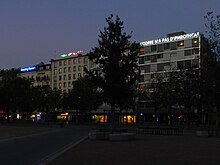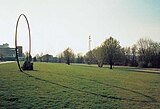
Installation art is an artistic genre of three-dimensional works that are often site-specific and designed to transform the perception of a space. Generally, the term is applied to interior spaces, whereas exterior interventions are often called public art, land art or art intervention; however, the boundaries between these terms overlap.
Public art is art in any media whose form, function and meaning are created for the general public through a public process. It is a specific art genre with its own professional and critical discourse. Public art is visually and physically accessible to the public; it is installed in public space in both outdoor and indoor settings. Public art seeks to embody public or universal concepts rather than commercial, partisan, or personal concepts or interests. Notably, public art is also the direct or indirect product of a public process of creation, procurement, and/or maintenance.

Thomas Hirschhorn is a Swiss artist who lives and works in Paris.
Alice Aycock is an American sculptor and installation artist. She was an early artist in the land art movement in the 1970s, and has created many large-scale metal sculptures around the world. Aycock's drawings and sculptures of architectural and mechanical fantasies combine logic, imagination, magical thinking and science.

Doug Aitken is an American multidisciplinary artist. Aitken's body of work ranges from photography, print media, sculpture, and architectural interventions, to narrative films, sound, single and multi-channel video works, installations, and live performance. He currently lives in Venice, California, and New York City.
Christian Jankowski is a contemporary multimedia artist who largely works with video, installation and photography. He lives and works in Berlin and New York.
Environmental sculpture is sculpture that creates or alters the environment for the viewer, as opposed to presenting itself figurally or monumentally before the viewer. A frequent trait of larger environmental sculptures is that one can actually enter or pass through the sculpture and be partially or completely surrounded by it. Also, in the same spirit, it may be designed to generate shadows or reflections, or to color the light in the surrounding area.
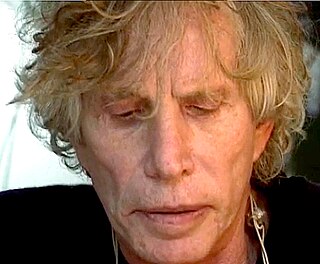
Dennis Oppenheim was an American conceptual artist, performance artist, earth artist, sculptor and photographer. Dennis Oppenheim's early artistic practice is an epistemological questioning about the nature of art, the making of art and the definition of art: a meta-art that arose when strategies of the Minimalists were expanded to focus on site and context. As well as an aesthetic agenda, the work progressed from perceptions of the physical properties of the gallery to the social and political context, largely taking the form of permanent public sculpture in the last two decades of a highly prolific career, whose diversity could exasperate his critics.
Zhao, Suikang (赵穗康) is a Chinese-American artist who works on different media and genres including painting, sculpture, site-specific installation, interdisciplinary art and monumental public art projects.

Simon Lamunière is a Swiss contemporary art curator and advisor.

Modern sculpture is generally considered to have begun with the work of Auguste Rodin, who is seen as the progenitor of modern sculpture. While Rodin did not set out to rebel against the past, he created a new way of building his works. He "dissolved the hard outline of contemporary Neo-Greek academicism, and thereby created a vital synthesis of opacity and transparency, volume and void". Along with a few other artists in the late 19th century who experimented with new artistic visions in sculpture like Edgar Degas and Paul Gauguin, Rodin invented a radical new approach in the creation of sculpture. Modern sculpture, along with all modern art, "arose as part of Western society's attempt to come to terms with the urban, industrial and secular society that emerged during the nineteenth century".
Alex Brewer, also known as HENSE, is an American contemporary artist, best known for his dynamic, vivid and colorful abstract paintings and monumental wall pieces. He has been active since the 1990s. In 2002 he began accepting commissions for artwork and over the course of the last decade has established a solid reputation as a commissioned artist, having appeared in several solo and group shows.
Ann Veronica Janssens is a Belgian contemporary visual artist born in 1956 in Folkestone, United Kingdom. She lives and works in Brussels, Belgium. Her work is an invitation to ephemeral experiences, which are at times delirious or vertiginous, and lead to the loss of control or landmarks, generating a sentiment of visual, physical, temporal or psychological fragility.
The Qatar Museums (QM) Public Art Department is responsible for overseeing the installation of artwork by renowned artists in the public realm in Qatar, creating an artist residency program for young local artists to help them develop their skills and horizons, organizing exhibitions featuring international artists and developing an online community of creative talent in Qatar and beyond. The QM has an ambitious plan that aims to make Qatar a world class cultural destination, notably in modern and contemporary art.

Elyn Zimmerman is an American sculptor known for her emphasis on large scale, site specific projects and environmental art. Along with these works, Zimmerman has exhibited drawings and photographs since graduating with an MFA in painting and photography at University of California, Los Angeles in 1972. Her teachers included Robert Heineken, Robert Irwin, and Richard Diebenkorn.
Tova Beck-Friedman is an American artist, sculptor, writer and filmmaker based in New York City. Her work has been exhibited in the United States, Australia, Israel, Europe, and Japan. Her work is in the collection of Grounds For Sculpture, Yeshiva University Museum, Newark Museum, Sculpture Garden, the Shoah Film Collection and the National Museum of Women in the Arts in Washington DC.
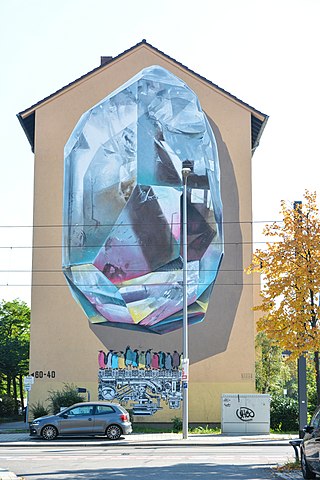
NEVERCREW is a Swiss street art group composed of Christian Rebecchi and Pablo Togni. NEVERCREW create large format murals, installations and urban interventions that emerge from their analysis of the relationship between humankind and nature.
Adrián Villar Rojas is an Argentinian sculptor known for his elaborate fantastical works which explore notions of the Anthropocene and the end of the world. In his dream like installations he uses aspects of drawing, sculpture, video and music to create immersive situations in which the spectator is confronted with ideas and images of their imminent extinction.
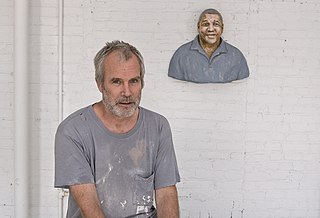
John Ahearn is an American sculptor. He is best known for the public art and street art he made in South Bronx in the 1980s.
Pritika Chowdhry is an Indian-born American artist, curator, and writer. She is known for her work in the socio-political domain.


